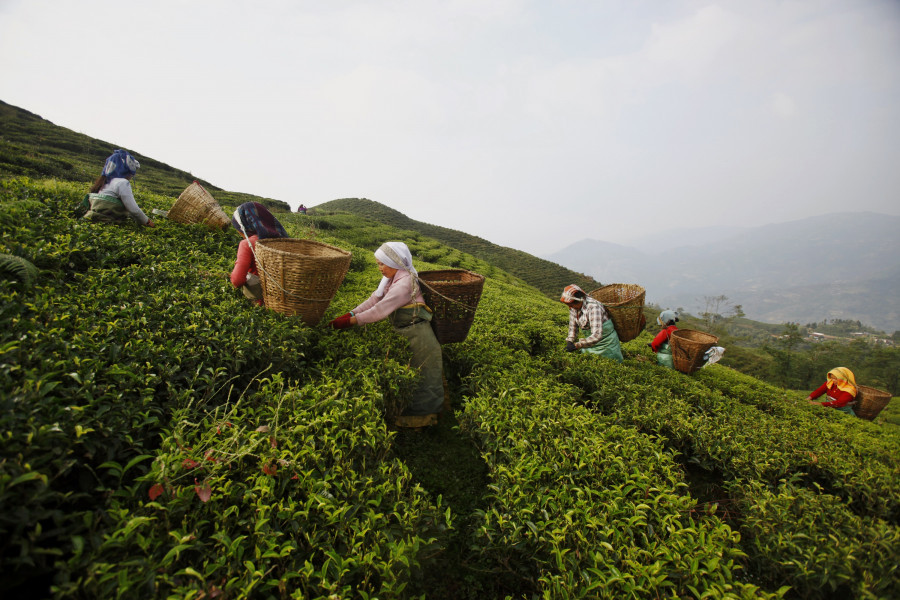Money
Novel project seeks to promote Nepali tea in the world market
The scheme will use the traceability system to track the product along the entire supply chain, officials say.
Biplav Bhattarai
The government has launched a novel project to promote Nepal's tea in the international market and improve its quality by using a system that tracks the product along the entire supply chain.
The Sustainable Export Promotion Project of Nepali Tea follows the implementation of the trademark Nepal Tea Quality from the Himalayas last September. The effort is expected to further enhance the quality of Nepali tea and enlarge worldwide sales, according to officials promoting tea cultivation.
The project is a milestone for expanding the international market by improving the quality of Nepali tea, said Bishnu Kumar Bhattarai, executive director of the Nepal Tea and Coffee Development Board.
"Farmers and traders need to be honest to make the effort a success," he said. "As the traceability system will be used, this project will do the work of branding by producing quality tea," he said.
The traceability system retrieves information at any stage by keeping a systematic record of farmers, operators, processors, transporters, wholesalers, packagers and retailers. This system is being implemented for the first time in agriculture.
It is claimed that the 36-month project will benefit all people engaged in bringing the tea from the tea plant to the lips of consumers.
Stakeholders expect the project, estimated to cost around Rs175 million, to provide significant support by way of technical assistance including organic certification.
"Spreading awareness among cooperatives and entrepreneurs, and adopting a traceability system and providing organic certification, international recognition can be gained," said Rabin Rai, general secretary of the Central Tea Cooperatives Association.
The project, run by the Ministry of Industry, Commerce and Supplies and the Nepal Tea and Coffee Development Board, is expected to help in resolving many problems in the tea sector.
Stakeholders have been pointing out the need for quality improvement and increased access to the international market to make the tea sector a source of sustainable agricultural income.
Locals have said that the project should not discriminate between farmer when resolving their issues. "Such projects should not discriminate on the basis of political affiliation," said Raju Katuwal, a farmer and entrepreneur from Panitar in Deumai Municipality. "The target group should be included according to the objective."
People have demanded that the project should improve the quality and help in marketing the product in the local market too.
Nepal's tea industry has a history going back 157 years, and the fact that efforts are being made to promote Nepali tea in the international market only now shows that there is a need for sincere efforts to make significant improvements.
The tea cultivation project at Buddhist Dham in Suryoday Municipality of Ilam was started to promote the product in the international market by improving the quality.
According to the board, Nepal produces 25 million kg of tea annually—20 million kg of CTC tea and 5 million kg of orthodox tea. Almost all the CTC tea produced in Nepal comes from Jhapa while orthodox tea is produced in various eastern hilly districts and parts of western Nepal.
Province 1 accounts for almost 95 percent of the tea produced in the country. Commercial tea production is being expanded to 13 districts besides the five districts in the eastern region.
Commercial tea production is being expanded to Lalitpur, Lamjung, Nuwakot, Kaski, Bhojpur, Sankhuwasabha, Kabhre, Ramechhap, Dolakha and other districts, he said. Lamjung is known for producing high-quality tea, almost all of which is exported, mostly to Germany, he added.
Currently, 80 percent of Nepal's tea exports go to India while the United States, Germany, Canada and Japan receive 10 percent of the shipments.
In recent years, Nepali orthodox tea has been gaining popularity in the international market mainly due to its quality, aroma and taste.




 6.1°C Kathmandu
6.1°C Kathmandu















